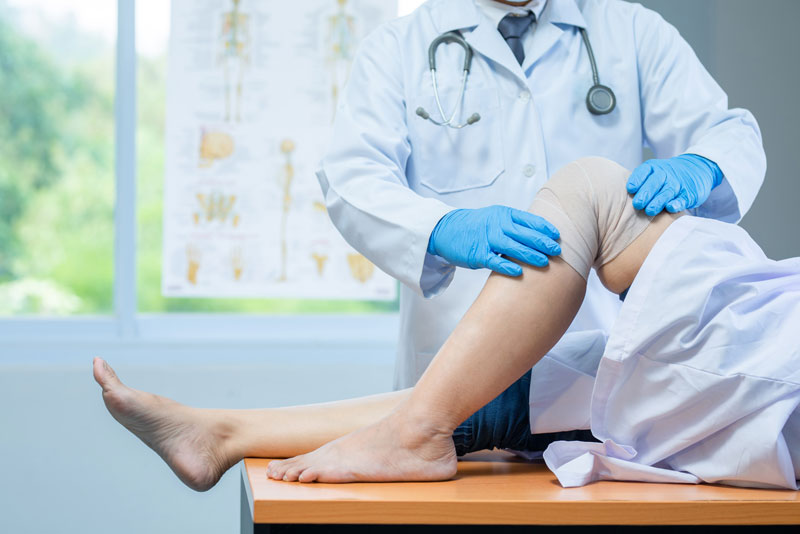The knee is a complex joint with comprising various ligaments, tendons, cartilage, and muscles that must work together seamlessly. Overuse knee injuries occur when the knee joint and its surrounding structures face strain due to repetitive stress or excessive use. Early diagnosis and prompt intervention prevents complications, improves treatment outcomes, and enhances knee health. Treatments often involve intricate surgical procedures, specialized devices, and various medical interventions, making orthopedic coding and billing complex. That’s why most providers turn to an orthopedics medical coding company to ensure that claims are accurately coded and submitted to insurance companies, reducing the risk of claim denials and ensuring proper reimbursement.

Streamline your orthopedic billing and coding, focus on patient care!
Reach out to us at (800) 670-2809!
4 Knee Overuse Injuries – Causes, Symptoms and ICD-10 Codes
Typically caused by activities like running, jumping, or cycling that involve frequent bending, twisting, or impact on the joint, overuse knee injuries arise from recurring microtrauma, incorrect joint alignment, and inadequate healing time after poor training techniques. Certain medical conditions can also increase the likelihood of overuse injuries.
Common overuse injuries in adults include Iliotibial Band Syndrome, Patellofemoral Pain Syndrome (PFPS), Patellar Tendinitis, and Tibial Plateau Stress Fracture.
Let’s take a look at these injuries and their ICD-10 codes:
Iliotibial Band Syndrome – Iliotibial band syndrome (ITBS) is a common cause of lateral knee pain in runners and bicyclists. It’s an overuse injury affecting the connective tissues on the outer part of the thighs and knees, causing pain and tenderness, especially above the knee joint. ITBS results from excessive friction due to a tight IT band rubbing against bones. Diagnosis involves a medical history assessment, physical examination, and possibly imaging tests like ultrasound or MRI. Treatment includes NSAIDs, icing, stretching, and strengthening exercises to alleviate pain and promote healing.
The ICD-10 codes for ITBS include –
- M76.3 Iliotibial band syndrome
- M76.30 Iliotibial band syndrome, unspecified leg
- M76.31 Iliotibial band syndrome, right leg
- M76.32 Iliotibial band syndrome, left leg
Patellofemoral Pain Syndrome (PFPS) – Patellofemoral pain syndrome (PFPS) causes front-of-the-knee pain around the kneecap, often known as runner’s knee. It’s common in athletes who jump and run, but non-athletes can also experience it. Symptoms include dull, aching pain in the front of the knee, making activities like kneeling, sitting, climbing stairs, and squatting challenging. The exact cause isn’t clear, but muscle imbalances, overuse, kneecap alignment issues, and past knee surgeries might contribute. Treatment involves rest, icing, medications, physical therapy, and braces. In severe cases, surgery like arthroscopy or realignment may be considered.
The ICD-10 codes for PFPS include –
- M22 – Disorder of patella
- M22.0 – Recurrent dislocation of patella
- M22.00 – Recurrent dislocation of patella, unspecified knee
- M22.01 – Recurrent dislocation of patella, right knee
- M22.02 – Recurrent dislocation of patella, left knee
- M22.1 – Recurrent subluxation of patella
- M22.10 – Recurrent subluxation of patella, unspecified knee
- M22.11 – Recurrent subluxation of patella, right knee
- M22.12 – Recurrent subluxation of patella, left knee
- M22.2 – Patellofemoral disorders
- M22.2X – Patellofemoral disorders
- M22.2X1 – Patellofemoral disorders, right knee
- M22.2X2 – Patellofemoral disorders, left knee
- M22.2X9 – Patellofemoral disorders, unspecified knee
- M22.3 – Other derangements of patella
- M22.3X – Other derangements of patella
- M22.3X1 – Other derangements of patella, right knee
- M22.3X2 – Other derangements of patella, left knee
- M22.3X9 – Other derangements of patella, unspecified knee
- M22.4 – Chondromalacia patellae
- M22.40 – Chondromalacia patellae, unspecified knee
- M22.41- Chondromalacia patellae, right knee
- M22.42 – Chondromalacia patellae, left knee
- M22.8 – Other disorders of patella
- M22.8X – Other disorders of patella
- M22.8X1 – Other disorders of patella, right knee
- M22.8X2 – Other disorders of patella, left knee
- M22.8X9 – Other disorders of patella, unspecified knee
- M22.9 – Unspecified disorder of patella
- M22.90 – Unspecified disorder of patella, unspecified knee
- M22.91 – Unspecified disorder of patella, right knee
- M22.92 – Unspecified disorder of patella, left knee
- M22.0 – Recurrent dislocation of patella
Patellar Tendinitis – Patellar tendinitis is tendon inflammation linking the kneecap (patella) to the shinbone (tibia). It joins thigh muscles to extend the knee, enabling activities like running, jumping, and kicking. Known as jumper’s knee, it affects athletes who jump frequently, like basketball players. Non-athletes can also experience it. Repetitive stress, common in sports or exercise, leads to tiny tendon tears and inflammation. Initial symptoms include pain and tenderness at the base of the kneecap, with possible swelling and burning. Pain worsens with tendon damage. Diagnosis involves physical exams and imaging like X-rays, MRI, or ultrasound. Treatment ranges from OTC drugs, therapy, and injections to rest and, if necessary, surgery. The relevant ICD-10 codes include –
- M76.5 Patellar tendinitis
- M76.50 Patellar tendinitis, unspecified knee
- M76.51 Patellar tendinitis, right knee
- M76.52 Patellar tendinitis, left knee
Tibial Plateau Stress Fracture– Tibial plateau fracture is a complex knee injury from a break atop the shin bone due to trauma like falls, accidents, or sports. Risk factors include weak bones (osteoporosis), infection, or mineral deficiency. Initial symptoms are pain, swelling, bruising, and joint pain. Diagnosis via X-ray, MRI, or CT scan. Early treatment is vital for movement and stability. Treatments include rest, splinting, pain relief, ice, elevation, and surgery (if severe). The ICD-10 codes for this knee injury include –
- M84.36 Stress fracture, tibia and fibula
- M84.361 Stress fracture, right tibia
- M84.361A Stress fracture, right tibia, initial encounter for fracture
- M84.361D Stress fracture, right tibia, subsequent encounter for fracture with routine healing
- M84.361G Stress fracture, right tibia, subsequent encounter for fracture with delayed healing
- M84.361K Stress fracture, right tibia, subsequent encounter for fracture with nonunion
- M84.361P Stress fracture, right tibia, subsequent encounter for fracture with malunion
- M84.361S Stress fracture, right tibia, sequela
- M84.362 Stress fracture, left tibia
- M84.362A Stress fracture, left tibia, initial encounter for fracture
- M84.362D Stress fracture, left tibia, subsequent encounter for fracture with routine healing
- M84.362G Stress fracture, left tibia, subsequent encounter for fracture with delayed healing
- M84.362K Stress fracture, left tibia, subsequent encounter for fracture with nonunion
- M84.361 Stress fracture, right tibia
Guidelines for Reporting Overuse Knee Injuries
The ICD-10 coding guidelines for overuse knee injuries are as follows:
- Document specific diagnosis: Assign the most specific diagnosis available based on the medical documentation. The diagnosis should accurately describe the type of overuse knee injury, such as patellofemoral pain syndrome, iliotibial band syndrome, or jumper’s knee.
- Use additional code: If a specific cause of the overuse knee injury is identified, such as excessive training or repetitive activities, a separate code should be assigned to indicate the cause.
- Document laterality: Specify the affected side, whether it is the right knee, left knee, or bilateral (both knees). Assign the appropriate code for the specific laterality.
- Code sequencing: Sequence the code for the overuse knee injury as the primary diagnosis when it is the reason for the encounter or the focus of the treatment. If other conditions are present, follow the sequencing guidelines based on the reason for the encounter or the condition that required the most resources or attention during the visit.
- Additional codes: Assign additional codes for any associated signs, symptoms, complications, or other relevant conditions documented in the medical record.
These guidelines are only general recommendations. For accurate coding, it’s essential to consult the complete ICD-10 coding guidelines and any other specific guidance. Outsourced othopedic medical billing and coding services are a practical option to ensure accurate and appropriate coding based on the clinical documentation. Outsourcing will allow orthopedic practices to focus on providing quality patient care while leaving the complexities of medical coding to experts in the field.




0 Comments